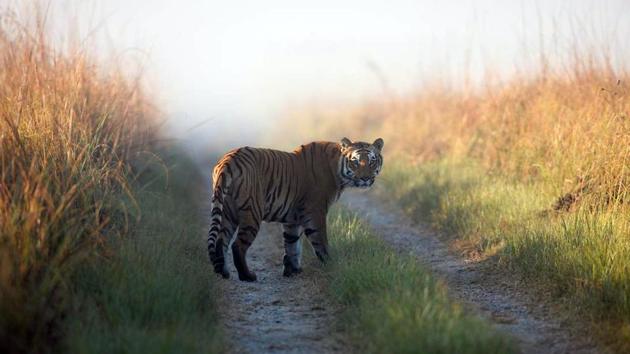Young and on the move: Sariska’s youngest tiger searching for territory away from home
The two-year-old sub-adult male tiger is now returning to Sariska Tiger Reserve, the home that he had left in search of a territory after being separated from its mother. Foresters in Rajasthan, meanwhile, are closely tracking its movement.
This one is young, lonely, and on the move. All that it is looking for is a piece of land, preferably covered in green, and with good supply of food, to settle down. Having travelled far and wide in last six weeks, ST-15, however, is yet to home in on a place it can call home.

The two-year-old sub-adult male tiger is now returning to Sariska Tiger Reserve, the home that he had left in search of a territory after being separated from its mother. Foresters in Rajasthan, meanwhile, are closely tracking its movement.
ST-15 was born to ST-9, one of the five female tigers trans-located from Ranthambore between 2008 and 2012 as part of the conservation efforts to revive tiger population in Sariska. Of the seven cubs born in Sariska after the conservation efforts started in 2008, ST-15 is the youngest.
The sighting of the two-year-old tiger at the Jamwa Ramgarh Sanctuary, about 50 km from Jaipur, a few days ago had cheered the forest department officials and wildlife enthusiasts as it was the first such sighting of a big cat since 1999-2000. It had also raised the hopes of revival of wildlife tourism at Jamwa Ramgarh Sanctuary.
However, officials said that the tiger was once again on the move and was midway between Jamwa Ramgarh and Sariska Tiger Reserve. The aerial distance of Sariska from Jaipur is about 111 km.
“ST-15, a sub-adult male, has separated from its mother and has been looking for its own territory. While it was spotted in Ajabgarh range, it is now once again returning back to Sariska and is midway. We are not disclosing the exact location for safety reasons,” deputy conservator of Forest (Sariska) Balaji Kari told HT.
The official said it was not clear whether the tiger would return to Jamwa Ramgarh Sanctuary. “It may or may not return. If it settles down at Jamwa Ramgarh, then it will definitely give a boost to tourism in the region,” he added.
At present, there are 14 tigers at Sariska – two dominant males and five females that were originally shifted to Sariska and their progenies, including ST-15. While three female tigers in Sariska have littered, two are yet to give birth. One adult tiger was poisoned in 2010. The national park is spread over an area of about 800 sq km with a core area of approximately 500 sq km.
For the past five weeks, ST-15 had been roaming in the Ajabgarh Range before reaching Jamwa Ramgarh. The tiger was first spotted on October 17 in the Dagota region and left after spending some days. It returned in the first week of November and since then was regularly spotted in the region.
A tiger normally demarcates 10-12 square km as its territory. If a rival enters the area, it leads to a fight for dominance with the stronger one retaining the territory.
According to Wildlife Institute of India (WII), as per population viability analysis carried out at Sariska, it is necessary to supplement the reserve with an adult male and an adult female tiger every three to five years for next 15 to 20 years to rule out possibility of extinction of tiger population.





